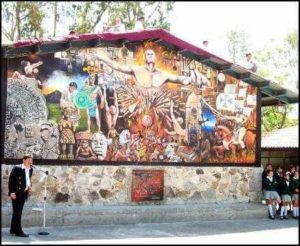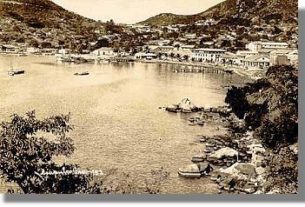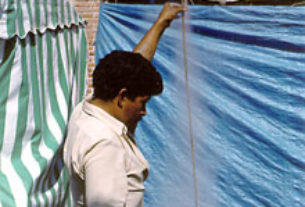Efren Gonzalez was born and raised in Ajijic, a student of the Santos Degollado Secondary School, at the top of Encarnacion Rosas. Never did the artist dream he would be the painter commissioned to adorn the huge wall facing the main entrance. The town of Chapala agreed to pay 1500 pesos, hardly the cost of paint and brushes. Efren realized, he would have to arrange for his own funding in order to commit to the project. So, he gathered a group of supporters made up of local friends and businesses, raising 9000 more pesos. Once the mural was in the works, Chapala upped its grant to 6000. The story unfolded.
Gonzalez is a young man of 28, who already has the responsibility of his wife, Reyna Maria, and their children, Leonardo, 4 and Paola, 8 months. Efren says one of the best rewards of doing the mural is that his children will know that it was a contribution made by their father.
The best part of the assignment for Efren was that he was given free reign over the content and subject matter. After six weeks work (mornings only) and 4 liters of acrylic paint, the result was the mural you see here. The work was unveiled in a dedication ceremony given at the school on Friday, June 28th with all the pageantry that is Jalisco.

The mural portrays Mexican history and endless possibilities for the future. The left side depicts the native origins of the region, the Mayas and Aztecs, their Gods and human sacrifices. The stooped figure of a native women bent in submission and carrying a light-skinned child, symbolizes the birth of a new nation, born from the conflict.
The center shows the battle that took place with the Spanish invasion. Spain, depicted on the right side, brought their armies and religion represented by monks carrying a cross. If we look closely, the crosses change to scythes as they approach the natives, striking a death knell into their ancient faiths and traditions. Above the raging battle we can see the image of a fetus in an explosion, which represents the birth of a new people.
Gonzalez says the mural remains unfinished at the top because the range of possibilities is not yet apparent. The huge figure dominating the picture is the children of today, rising out of the battle. Behind that persona, Gonzalez shows endless possibilities in science, art, and music.
The message: The Mexican people can do anything they want, it is up to the children; hence, the importance that the work is located in a schoolyard. Every day, the students come face to face with their origins and choices for a brilliant tomorrow.
Efren said the experience of creating the mural went far beyond his expectations in many ways. He learned about working with politicians and how the people of this town would help and support him. Gaining the respect and comradeship of the students and teachers was central.
Efren started the work when the students were on holiday; the place was deserted and lonely, when he set about his task. Once the children returned, everything changed. The mural started to take on more meaning for the artist. He noticed that as the work progressed, a whole new attitude developed about the appearance of the schoolyard. It was kept neater and plants were brought in.
“It was wonderful,” Efren’s flashing eyes sparkle. His mural, his school, his town, his friends…what a life lesson!
This article appears courtesy of the Chapala Review, a monthly Newspaper published in Ajijic, Jalisco, Mexico. The focus is the Lake Chapala area. The goal is to provide quality information about the area, its stories, events, history, culture and people.



